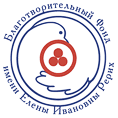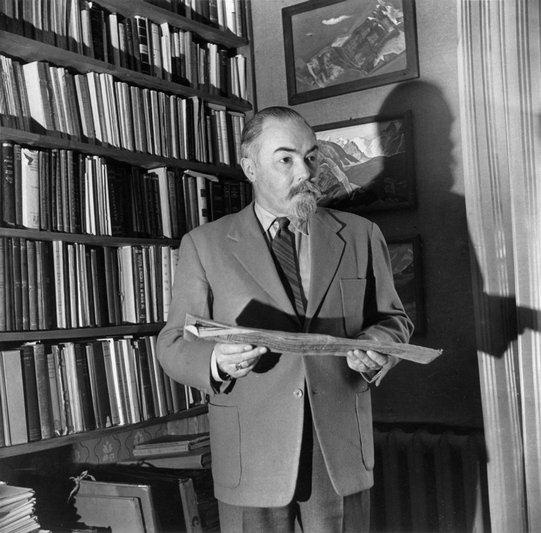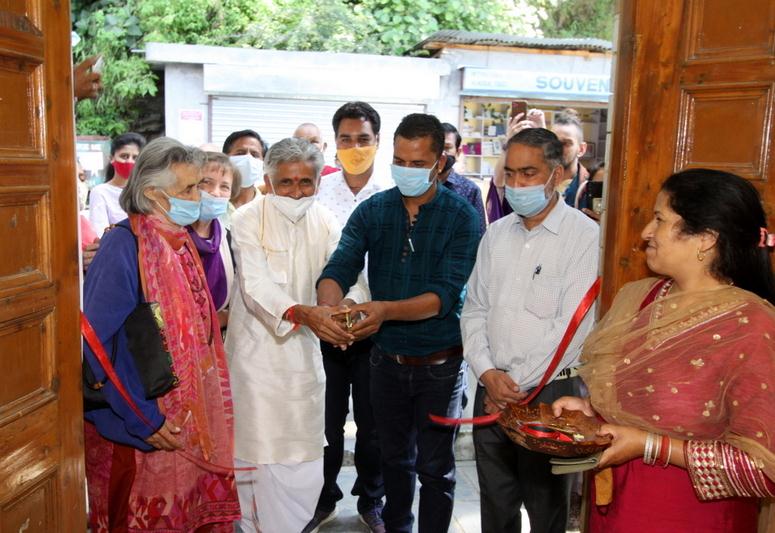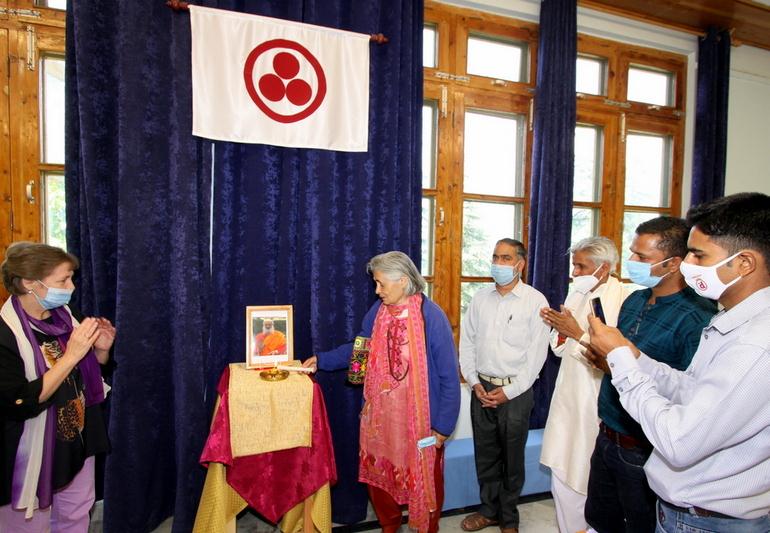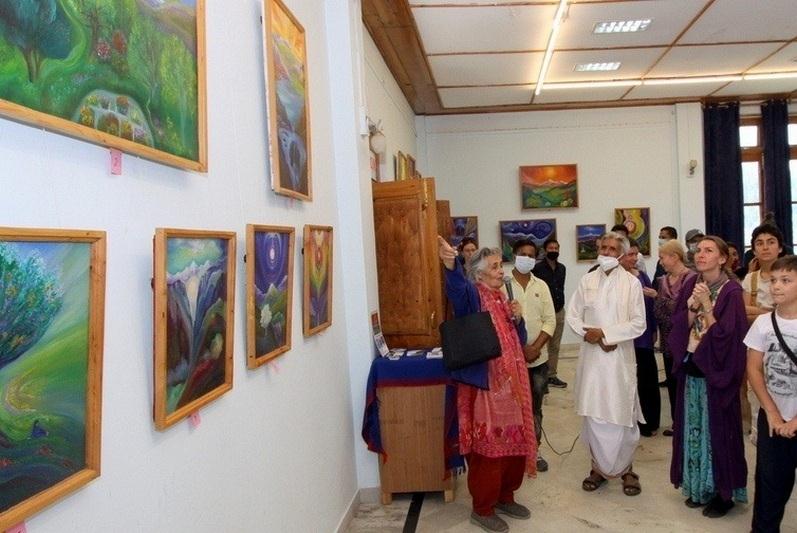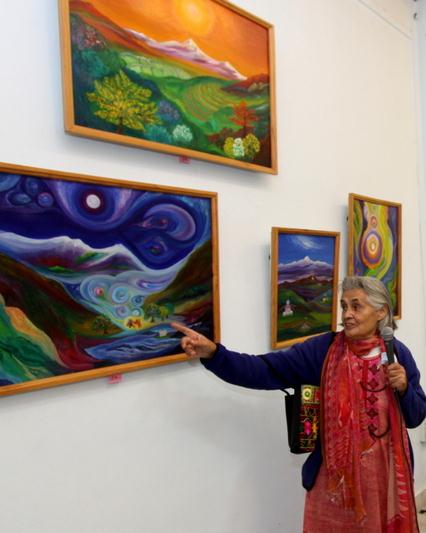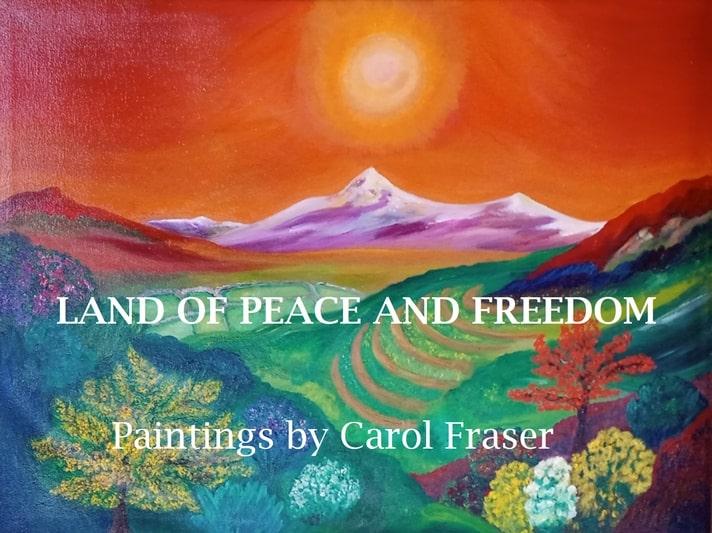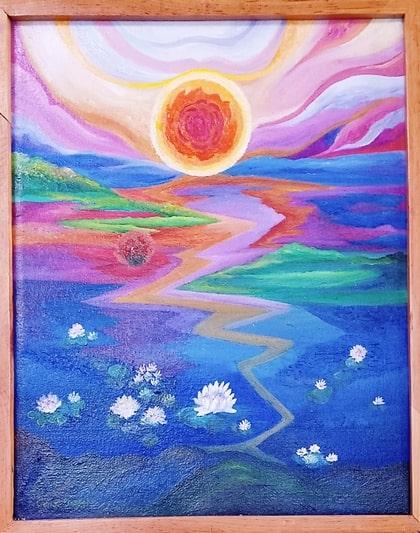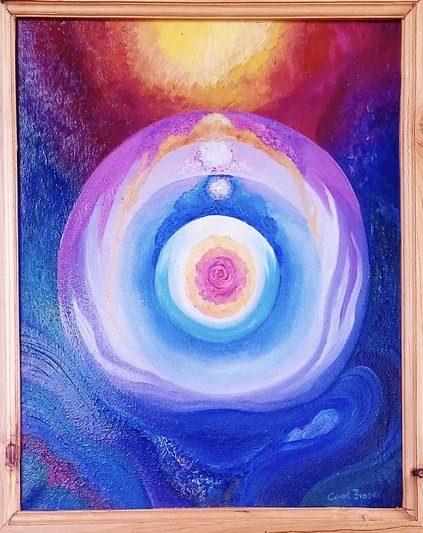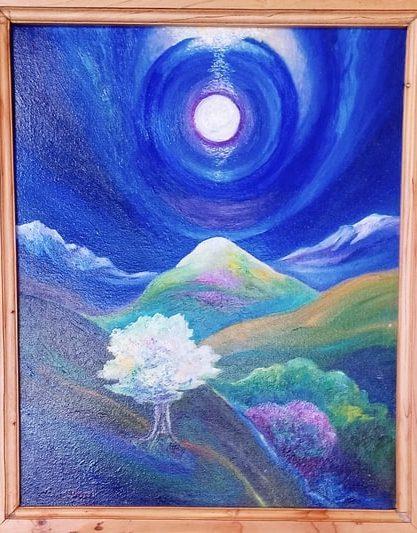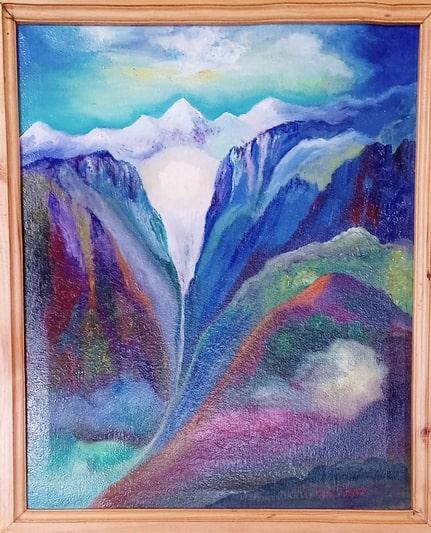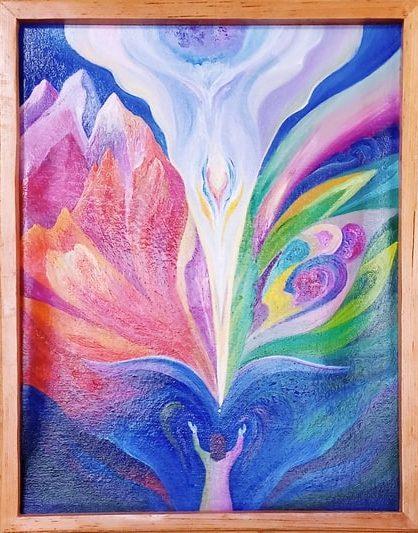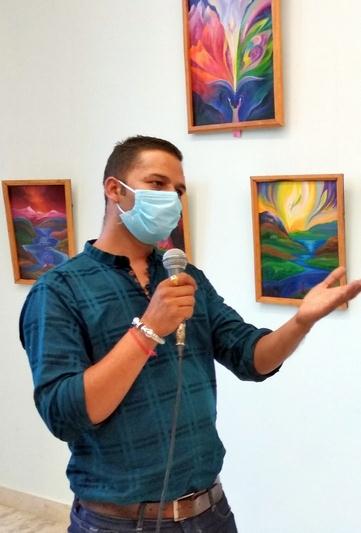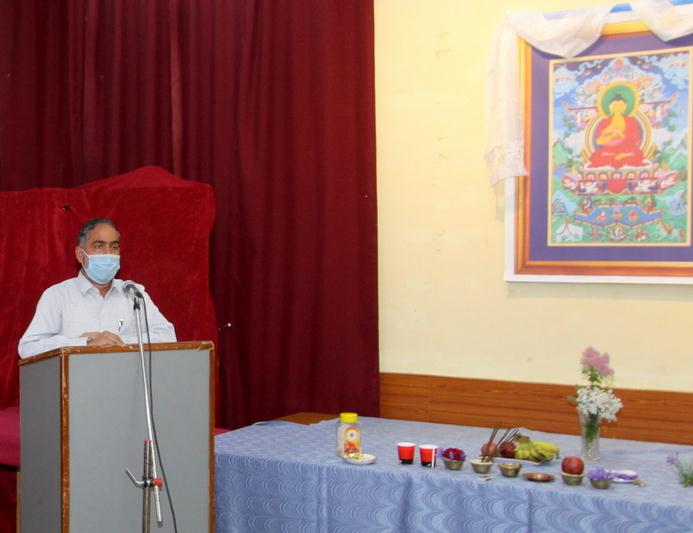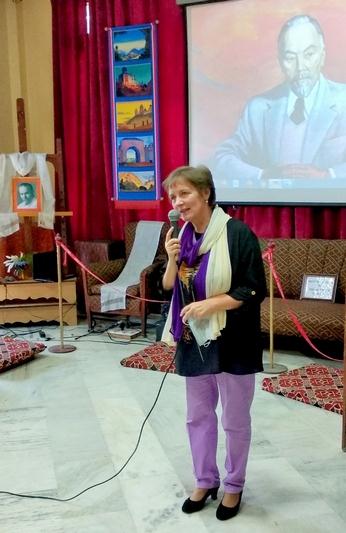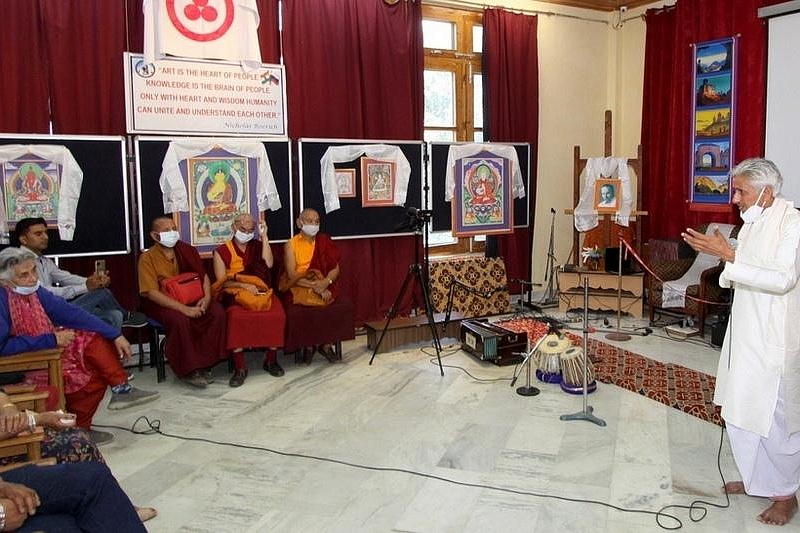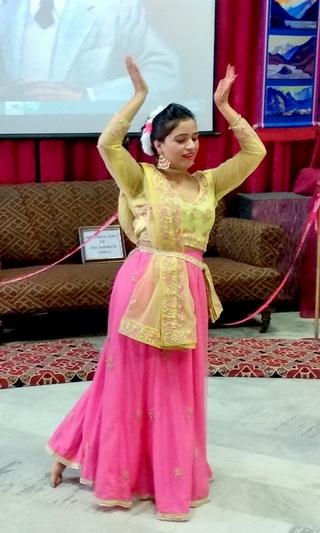“He had no limits in the field of knowledge …”. 119th Birth Anniversary of George Roerich in IRMT
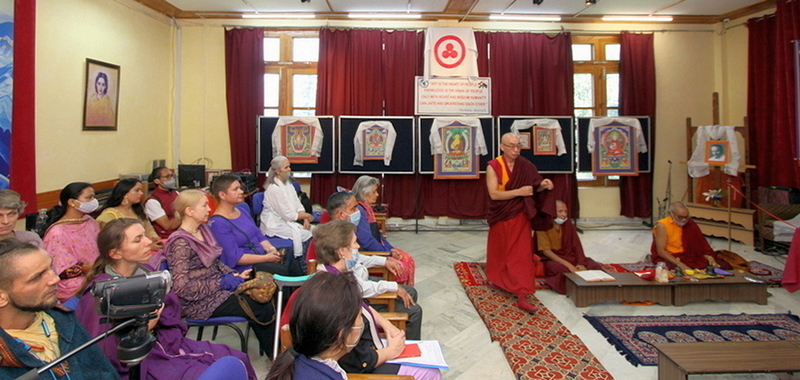
|
18th August 2021 Indian and Russian guests came together in the Roerichs Estate to celebrate 119th Birth Anniversary of George Roerich, elder son of Nicholas and Helena Roerich, a renowned orientalist, buddhologist, linguist, archeologist, traveller, explorer of Central Asia history and culture.
In accordance with tradition the celebrating started with Guru Puja (Lama Choepa) ceremony. This Buddhist ritual is dedicated to a spiritual Teacher; lamas praise high qualities of Guru, commitment to him as a necessary condition of gaining heart blessing and movement upon the path to enlightment. Pangang Gompa Lamas have conducted that sacred ceremony in the IRMT at George Roerich’s Birth Anniversary for some years as a sign of especial respect to the Russian scholar, having deepest scientific and spiritual knowledge and becoming the true Teacher for his disciples.
It should be mentioned that one of George Roerich’s highest excellence was translating the Tibetan book “Blue Annals. History of Buddhism” by Go Lotsawa Zhonnu-pel into English. Till today scholar Buddhist lamas mark that only luminous being, deeply attained spiritual Oriental knowledge could translate the 10th Chapter of the work dedicated to Kalachakra – sacred Shambala Teaching.
“As a scholar, George Roerich was one of the greatest encyclopedists of East and West,” wrote Nirman Singh, Director of Sikkim Research Institute of Tibetology. “A linguist, explorer, archeologist, art critic, historian and Culture expert, he had no limits in the field of knowledge. The boundaries between East and West or different branches of knowledge did not exist for him. First and foremost, he was interested in a man. He was a true humanist.”
An inauguration of the painting exhibition by Carol Fraser, English artist became truly symbolic as named “Land of Peace and Freedom”. The red ribbon was solemnly cut by Chief guests of the IRMT: Mr. Pardeep Kumar Thakur – the President of Naggar Panchayat and Dr. Om Kumar Sharma – Founder and Director of Sri Vyas Sanskrit College in Kullu.
Shambala, the Land of Peace and Freedom is our true Earth and our future, thinks Carol Fraser. Shambala exists in reality but at a higher vibrating level of our planet. Only few people can get Shambala in physical bodies but anybody can get there in their hearts if a person choses honesty, free world and the most important of all – the truth.
One of the paintings at the exhibition is named “Remembering That Land”. It is full of tranquility and beautiful memories – memories about the Land of our souls, about the hidden kingdom on our planet. The painting is inspired by Franz Schubert’s music – one of Carol’s favorite composers. Carol used to be a pianist in her early years and many guests of the exhibition mentioned musicality of her paintings, rhythmic sound of their bright clear colors.
There are two more paintings dedicated to Schubert’s music. One of them shows an early morning in mountains, the Sun is just rises over the peak, the atmosphere is very clean. Suddenly dark shades of thunder clouds change the rhythm, bringing motives of anxiety, excitement, tension… And again – as in the music – we see a transit from a violent thunderstorm to transcendental tranquility.
A sunset in very deep shades is in another painting. According to the artist, that work is her recognition to the composer who left this life very early; she is encouraged by the composition created by Schubert in the last year of his life. Looking at the painting we understand that the author in his composition has a conversation with himself, taking farewell to this life but knowing the death is not the end, it is just transferring to another world.
Carol Frazer has lived in Himalaya for many years. With blessing of her spiritual Teacher Shin she travels a lot, teaches technics of meditation and conducts Teachings.
In her creative work she reflects the main idea of her Guru: the humanity is in the process of transition to the New World and we have to get particular level of spiritual development at the point of the transition. The more people can come together as a free community to help the Earth and establish healthier, more worthy forms of social and economic life, the less severe will have to be the measures that will come from the Cosmos.
The exhibition of reproductions of thangkas from the collection of International Centre of the Roerichs (Moscow) was presented to the guests in Conference Hall of the IRMT. The main part of thangkas of the Roerichs was collected by George Roerich and two thangkas: “Sitatapatra” and “Sita Manjughosha” were gifted to Helena Roerich by the spiritual Teacher. George Roerich was one of the first researchers of Buddhist thangka art; his book “Tibetan Paintings” remains actual and requested nowadays. The thangkas presented at the exhibition were described by Natalia Zubchenko, Assistant of Russian Curator, IRMT.
Krishna Tashi Palmo, an artist from Lahaul (Himachal Pradesh) spoke about art of thangka creating as special “secret” art. Since these are holy images that are retained in thangkas the process of preparing to thangka painting — stretching a canvas on a frame, putting on a coat, choosing colors – deeply connects with “truthful” condition of the artist, with highness of their thoughts, purity of the emotions, spiritual mood. So creating Buddha image the artist’s focus of attention directs to accurate painting the main qualities of Buddha – compassion, kindness. Also it is important for the artist to pay attention to minute details of the composition, right painting iconic figures. Only balance of concentration on internal and external work allows the artist to create a real masterpiece of “secret” art.
The official part of the celebrating program was opened by welcome speeches of Mr. Pardeep Kumar Thakur, the President of Naggar Panchayat and Mrs. Shushma Sharma, who held this position earlier. It has to be said that Naggar Panchayat always gives overall support to the Roerich Trust and our close collaboration is critical to further development and wellbeing. It was said in the welcome speech by Mrs. Larisa Surgina, Russian Curator performing in the IRMT on the direction from International Centre of the Roerichs (Moscow). She appreciated the representatives of the authorities, chief guests, Pangang Gompa Lamas and everyone who that day joined the celebrating of 119th Birth Anniversary of George Roerich.
Mr. Amarjeet Anand welcomed the participants on behalf of Mr. Ramesh Chandra, Indian Curator and Indian team of the Roerich Trust. He expressed hope that when the situation with the pandemic is improved artists, guests can as before take part in plenty events organized annually by the IRMT on the territory of the Roerichs Estate.
Larisa Surgina in her speech turned her attention to the personality of George Roerich, whose exceptionalism and deepness we have to investigate for a long time. It was a unique person showing many talents even in his childhood. Nicholas Roerich remembered that already at the age of 3–4 George wrote his first poem “At last I was born.” And then the poem said about a camel ride trip. So East, Asia became the boy’s biggest dream since early years. Already in school he was seriously interested in history of Egypt, Mongolia and later India. Helena Roerich remembered that at the age of one and a half – two years old his favorite books were museums and exhibitions catalogues. And art experts estimating his children and youth drawings remained until today say that he would become a great artist. He was proud a lot by his ancestor – Mikhail Kutuzov, Field-Marshal, a hero of the War of 1812 and had thousands of toy soldiers as he was keen on art of war.
Child interests escalated into key matters. He got education in School of Oriental Languages at London University; he studied Indian philology in Harvard; he continued education in School of Oriental Languages at Paris University and studied military science there at the same time.
By the beginning of Nicholas Roerich’s Central-Asian expedition George Roerich was 21 years old. He knew Sanskrit, Tibetan, Chinese and other languages and performed duty of a translator. He held responsibility for exhibition guarding and the people security. Also he started to practice own scientific research. His first visible result was a brilliant monograph “Tibetan Paintings” finished by George at the age of 23 years old that showed his love to art and East and his interest to Buddhism. His book “Trails to Inmost Asia” that he wrote at the end of the expedition put the young researcher in a row of Asia pioneering explorers.
So it is not an accident that exactly the Roerich’s elder son became the director of the Urusvati Himalayan Research Institute, created by the Roerichs in Kullu Valley. Along with his parents and younger brother he created a conception of the Urusvati as a complex research institute aimed to join East science and West spiritual knowledge and set main directions of its comprehensive activities. He connected with Indian, European and American scientists, Tibetan lamas, doctors of traditional medicine. He collected the richest research library. He published three volumes of the Urusvati journal. At the same time he continued to study culture, religion, dialects of Tibet, publish research works and translations.
George Roerich accommodated in himself a scientist and an artist, a warrior and humanist, practical person and spiritual person. He united in himself West and East and returning to Russia he brought there not only treasured knowledge about East history and culture but also primal Oriental wisdom that became a part of his nature. During three short years in Russia he could realize a lot of aims. Not only in a science field. He brought to Russia a part of his parents’ creative heritage and introduced spiritual wealth of the Roerichs family to Russians.
His unique gift to unite people, gift of synthesis let him become an outstanding teacher and leave behind outstanding disciples not only in Russia. Tsering Dorje, scholar, buddhologist, linguist, Himalaya researcher was one of such disciples. He was very young when met George Roerich. That meeting left a lasting impression with the boy and mostly defined his development as a scientist. He continued to study works of his Teacher for the whole life every time being impressed by the level of the personality and degree of knowledge. He was planning to write a book about the Russian scholar but no sooner he did it. He was a frequent visitor in the IRMT and all his speeches he dedicated to George Roerich.
Having finished her story Larisa Surgina turned it over to Prof Om Kumar Sharma. The professor said that for about five years he had an honor to communicate with Tsering Dorje who was not only the great scholar but a highly spiritual person. In his mind there is strong resemblance in nature of Tsering Dorje and George Roerich in their view of life. They both put together all ways of Oriental wisdom. Living in Himalaya, sacred heart of spirituality, they spread their knowledge all over the world.
Professor Om noticed that he see similarity in thoughts and philosophical conceptions on either George Roerich’s works or Vedanta and Buddhism. “Roerich’s light,” said the professor, “can illumine the whole Universe. It is our fortune that such a personality lived in Kullu Valley. It is a place of great deities. <…> Krishna in Bhagavad-Gita said that Himalaya is a soul of deities. And exactly that place – Naggar is a divine seat of the deities, the Light house. From here we can spread light of knowledge, spirit, love, art. Because, as great Vivekananda said, every religion has three steps – rituals, mythology and principals. We can see all of them in Carol Fraser’s pictures. Rituals come behind physical matters and then behind them is mythology and then principals of light and knowledge. We can’t separate knowledge from action. Will power, knowledge and action are never separated.”
In accordance with Vedic tradition those ideas are linked to relations between a Master and a disciple who preserve each other, work with each other and never confront each other. Any knowledge coming from a Master to a disciple is a lamp that gives light to the whole humanity. It is not very easy task. Interaction of a Master and a disciple is a great task of Vedic tradition. That is why it is a big fortune that a great Master George Roerich and his great disciple Tsering Dorje came in the world in our times. It is our fortune that now we have Buddhist lamas here. We have to follow that path, that destiny – the path of libration, knowledge, love, universe, Cosmos. Everything comes to spirituality because spirit knows everything. I don’t know Russian language but my heart knows. If we don’t know any culture our hearts know. It is a connection of hearts. As Vivekananda said intellect goes few steps and stops. This is heart that enters nature of things. George Roerich, Tsering Dorje, other great Masters, Buddhas showed us the path we should follow – the path of spiritualism that unites all creations, humanity and nature.”
Hereafter Carol Fraser, the artist said about the Land of Peace and Freedom. This Land is in us if we are truly humans who allow other humanity to be free. Of course we need a very big heart and big mind for it.
“Human beings on the Earth are in great danger, said the artist. – We are polluting the Earth, we are destroying the living nature and we think we can replace nature with what we call “science”. We have to remember that the science today is no longer free. Big money manipulates science.” Carol asked everybody not to allow the god of money to get us, remember about our humanity, spirituality, remain being open to beauty. Beauty and art, these are our keys to spirituality, to the true human being.
“Great Teachers of Shambala want to connect with the Earth. They want to help humanity and inspire humanity to become a higher and better civilization with better science. Each of us now is a great reformer and recreator of a better Earth.”
Carol appreciated the IRMT team for a possibility to speak about important issues in the Roerichs Estate – a special place that unites art and spirituality.
In return Larisa Surgina noticed that the ideas shared by Carol are very close to ideas of Living Ethics or Agni Yoga brought to the world by Roerichs. Living Ethics is a part of great Kalachakra Teaching and that spiritual Knowledge was able to be brought in the world only by people with supreme intellect and what is more important – with the highest inner ethic and spirituality, people with inner Light. George Roerich was that person.
The celebrating program finished with beautiful music program prepared by teachers of Helena Roerich Academy of Arts for Children under the IRMT.
The Russian participant of the celebration expressed global guests’ impression:
“The main thing is extremely warm atmosphere and sensation of unity. Although the participants of the program spoke different languages the idea of every speaker was the same: how to unite and save our planet in these hard times. Living and honest words, without reading from notes allowed everybody to feel that the Roerichs Estate in Naggar is not just a museum but a spiritual center that works for the future of our planet.”

